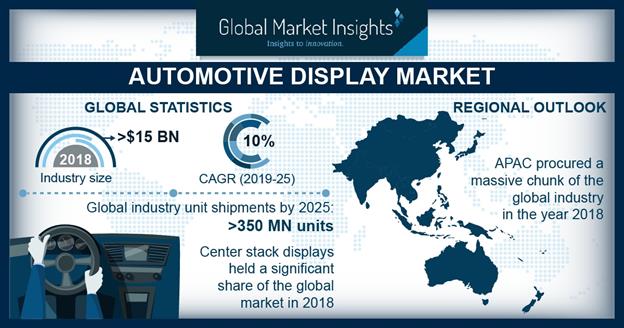The earlier idea of having a small screen for the central console and CD players for basic operations has completely changed with new, larger, more efficient, and technically-advanced displays coming into picture.
Infotainment & navigation systems have become standard features in most cars, whereas luxury car manufacturers have been shifting to the digital instrument clusters, multiple displays in car cabins, rear seat entertainment displays, and head-up displays.
The report indicates Audi A8 and Mercedes-Benz S class as the main trend initiators of dual screens and multiple touch surfaces; and with the popularity of rear seat entertainment and in-vehicle infotainment systems the automotive display market has seen growth.
An increased need for vehicle safety features has also resulted in technologies such as augmented reality becoming a reality. Many luxury car brands such as BMW, Jaguar, and Mercedes-Benz, have already implemented AR head-up displays in their cars.
In addition, car manufacturers in automotive display market are implementing digital instrument clusters that display more information than just speed and distance. Visteon developed the first all-digital instrument cluster and cockpit, which shows displays throughout the car’s dashboard with curved display panels.
Also responsible for the rapid growth in the automotive display market is the sales of passenger cars, the rising demand for connected vehicles, and a high disposable income, particularly in Asian & European economies. Europe is expected to be a dominant region for the market due to the presence of a large number of luxury car manufacturers. The disposable income in Europe is higher too, which the report says will result in the demand for expensive ADAS systems with more convenience, safety, and comfort features.
Currently, most of the display panels used in these systems are TFT LCD displays, whereas OLED panels are expected to be more prominent in the automotive display market in the coming years. Due to organic materials and the use of thin plastic substrates, OLED panels provide the freedom for design as flexible and transparent displays can be made with OLED. Companies such as LG and Samsung are focusing more on OLED panels for automotive displays. Manufacturers are focusing on reducing mechanical components and bringing in more interactive surfaces in their cars. This will augment the automotive display market in the coming years, according to Global Market Insights.

The report highlights Continental, Visteon, Panasonic Automotive Systems, Denso, and Robert Bosch as the key players in the industry, offering different products such as instrument clusters, head-up displays, etc.
With the automotive display market facing intense competition, with companies focusing on product innovations and differentiation to increase their market share, these five companies will be looking to bring in new technologies to gain an advantage. For example, Visteon has developed its completely digital cockpit with curved displays for cabin.
Though the automotive display market has a high growth potential, there are some challenges and factors restraining its growth, one being the high costs of ADAS. The costs associated with technologies such as AR and OLED panels are higher, leading to high prices of cars and that's limiting the automotive display market.
The touch surfaces are not yet as reliable as mechanical buttons and systems. In addition, larger displays if not implemented properly, results in difficulty of operation, making it unsafe for drivers. Global Market Insights points to Tesla’s large display as an example, describing it as difficult to operate due to its size and drivers having to look at the display every time while operating it. This problem is being resolved with the introduction of 3D touch surface displays by Continental.







